Counselling Theory and Practices
VerifiedAdded on 2023/01/13
|15
|3747
|99
AI Summary
This study material explores the concept of counselling theory and practices. It includes a case summary, assessment, diagnosis, and treatment planning. Suitable for psychology students.
Contribute Materials
Your contribution can guide someone’s learning journey. Share your
documents today.
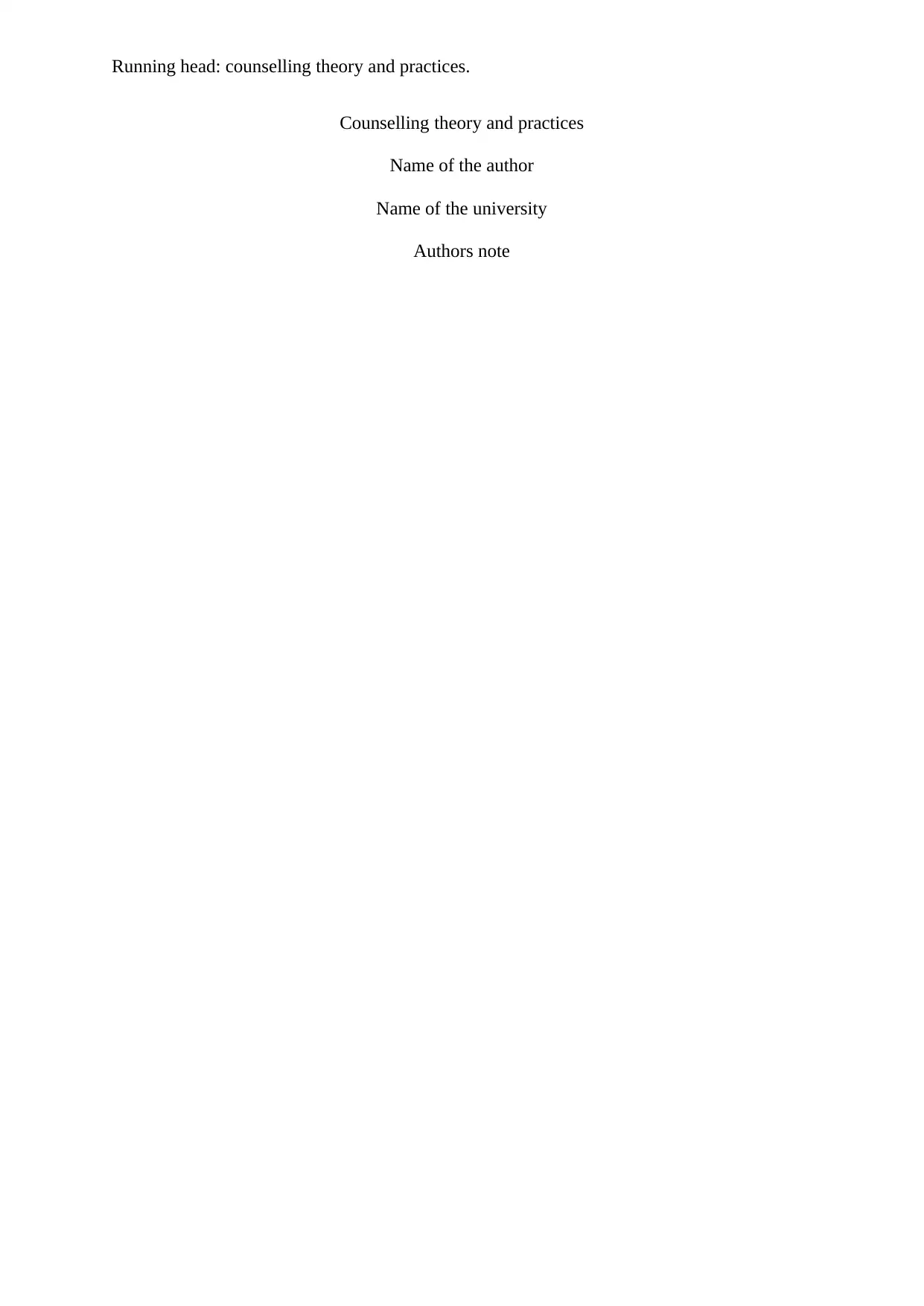
Running head: counselling theory and practices.
Counselling theory and practices
Name of the author
Name of the university
Authors note
Counselling theory and practices
Name of the author
Name of the university
Authors note
Secure Best Marks with AI Grader
Need help grading? Try our AI Grader for instant feedback on your assignments.

Running head: counselling theory and practices.
Part one
1) Case Summary.
The move Room is based on the novel originally written by Emma Donoghue. This story is
narrated form the point of view of a five-year-old boy, who was kept captive in small room
along with his mother (ma). In this story jack lives along with ma in a small room that
contains a small kitchen, a basic bathroom a wardrobe and a TV set. Jack was accustomed to
these things and started believing that these were the only things, which were real. Ma was
not willing to disclose the truth in front of his little boy because she was convinced that she
would not be able to provide him with the better opportunity. In this way, Jack started living
in this self-made and self-proclaimed ethereal world but it is also interesting to watch the way
he was raised. Ma indeed was a good mother and always made him feel that he is the hero of
her life. Continuous address of Jack as Prince Jacker Jack, as Samson and Superman made
him inculcate virtues like bravery and courage. Thus, the raising was very important because
it was bravery that turned out to be the hope in the life of Ma and Jack himself. This does not
mean that jack was devoid of fear rather he had that capacity to overgrow the fear. However,
it does not mean that he will not be the victim of psychological trauma. Even if he is hero he
is only kid who keeps on counting his teeth to feel normal. This is because he has lost the
ability to comprehend what is real and what is figment of his imagination. Five years in his
life he taught himself to believe something but again, suddenly in rapid change of events the
meanings that he attached to the world turned upside down.
Identifying information- Prior living, Family, Prior treatment, Living-Situations-Now.
Presenting problem/chief complaints- History of the problem, Prior attempts to solve the
problem.
Part one
1) Case Summary.
The move Room is based on the novel originally written by Emma Donoghue. This story is
narrated form the point of view of a five-year-old boy, who was kept captive in small room
along with his mother (ma). In this story jack lives along with ma in a small room that
contains a small kitchen, a basic bathroom a wardrobe and a TV set. Jack was accustomed to
these things and started believing that these were the only things, which were real. Ma was
not willing to disclose the truth in front of his little boy because she was convinced that she
would not be able to provide him with the better opportunity. In this way, Jack started living
in this self-made and self-proclaimed ethereal world but it is also interesting to watch the way
he was raised. Ma indeed was a good mother and always made him feel that he is the hero of
her life. Continuous address of Jack as Prince Jacker Jack, as Samson and Superman made
him inculcate virtues like bravery and courage. Thus, the raising was very important because
it was bravery that turned out to be the hope in the life of Ma and Jack himself. This does not
mean that jack was devoid of fear rather he had that capacity to overgrow the fear. However,
it does not mean that he will not be the victim of psychological trauma. Even if he is hero he
is only kid who keeps on counting his teeth to feel normal. This is because he has lost the
ability to comprehend what is real and what is figment of his imagination. Five years in his
life he taught himself to believe something but again, suddenly in rapid change of events the
meanings that he attached to the world turned upside down.
Identifying information- Prior living, Family, Prior treatment, Living-Situations-Now.
Presenting problem/chief complaints- History of the problem, Prior attempts to solve the
problem.
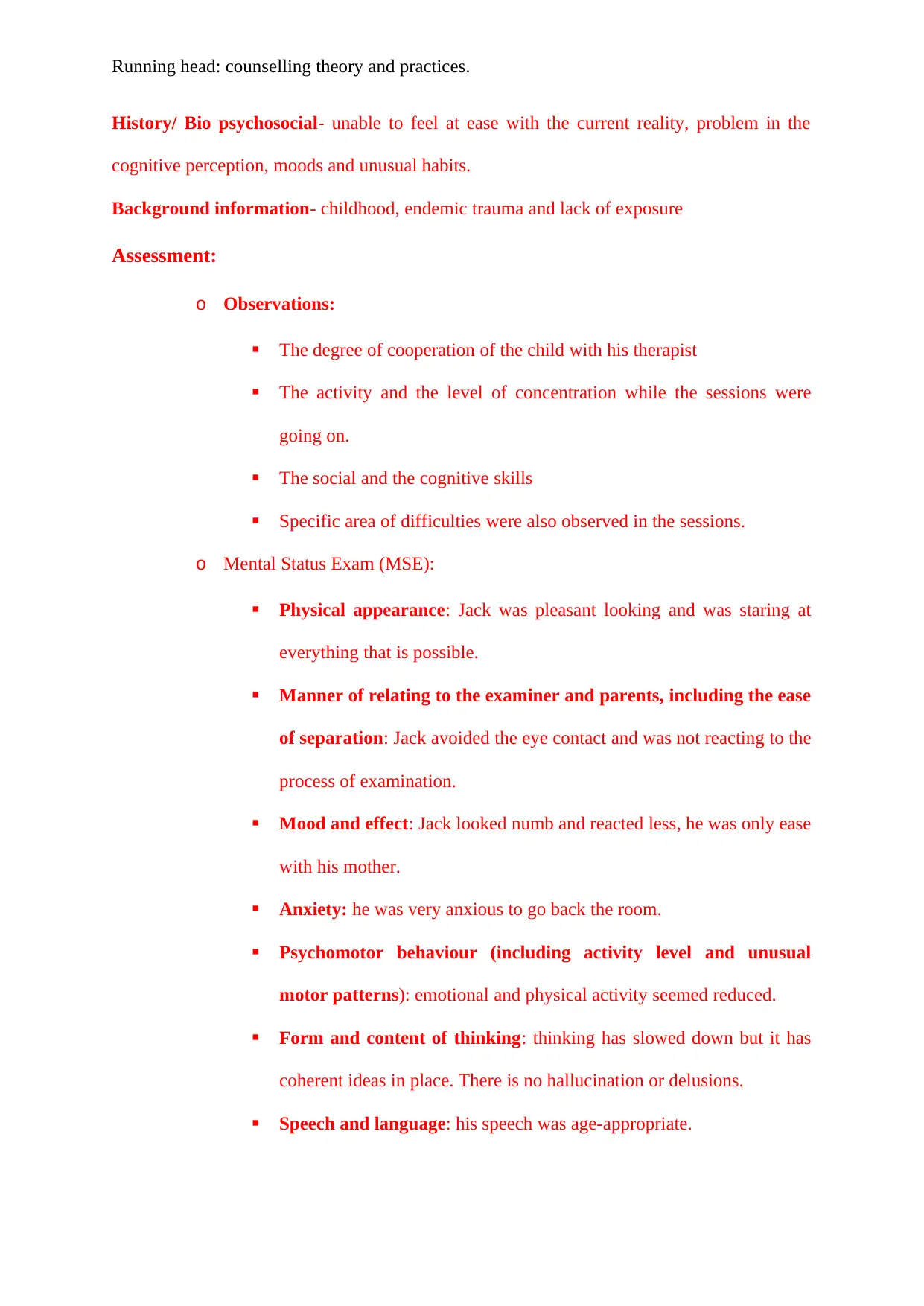
Running head: counselling theory and practices.
History/ Bio psychosocial- unable to feel at ease with the current reality, problem in the
cognitive perception, moods and unusual habits.
Background information- childhood, endemic trauma and lack of exposure
Assessment:
o Observations:
The degree of cooperation of the child with his therapist
The activity and the level of concentration while the sessions were
going on.
The social and the cognitive skills
Specific area of difficulties were also observed in the sessions.
o Mental Status Exam (MSE):
Physical appearance: Jack was pleasant looking and was staring at
everything that is possible.
Manner of relating to the examiner and parents, including the ease
of separation: Jack avoided the eye contact and was not reacting to the
process of examination.
Mood and effect: Jack looked numb and reacted less, he was only ease
with his mother.
Anxiety: he was very anxious to go back the room.
Psychomotor behaviour (including activity level and unusual
motor patterns): emotional and physical activity seemed reduced.
Form and content of thinking: thinking has slowed down but it has
coherent ideas in place. There is no hallucination or delusions.
Speech and language: his speech was age-appropriate.
History/ Bio psychosocial- unable to feel at ease with the current reality, problem in the
cognitive perception, moods and unusual habits.
Background information- childhood, endemic trauma and lack of exposure
Assessment:
o Observations:
The degree of cooperation of the child with his therapist
The activity and the level of concentration while the sessions were
going on.
The social and the cognitive skills
Specific area of difficulties were also observed in the sessions.
o Mental Status Exam (MSE):
Physical appearance: Jack was pleasant looking and was staring at
everything that is possible.
Manner of relating to the examiner and parents, including the ease
of separation: Jack avoided the eye contact and was not reacting to the
process of examination.
Mood and effect: Jack looked numb and reacted less, he was only ease
with his mother.
Anxiety: he was very anxious to go back the room.
Psychomotor behaviour (including activity level and unusual
motor patterns): emotional and physical activity seemed reduced.
Form and content of thinking: thinking has slowed down but it has
coherent ideas in place. There is no hallucination or delusions.
Speech and language: his speech was age-appropriate.
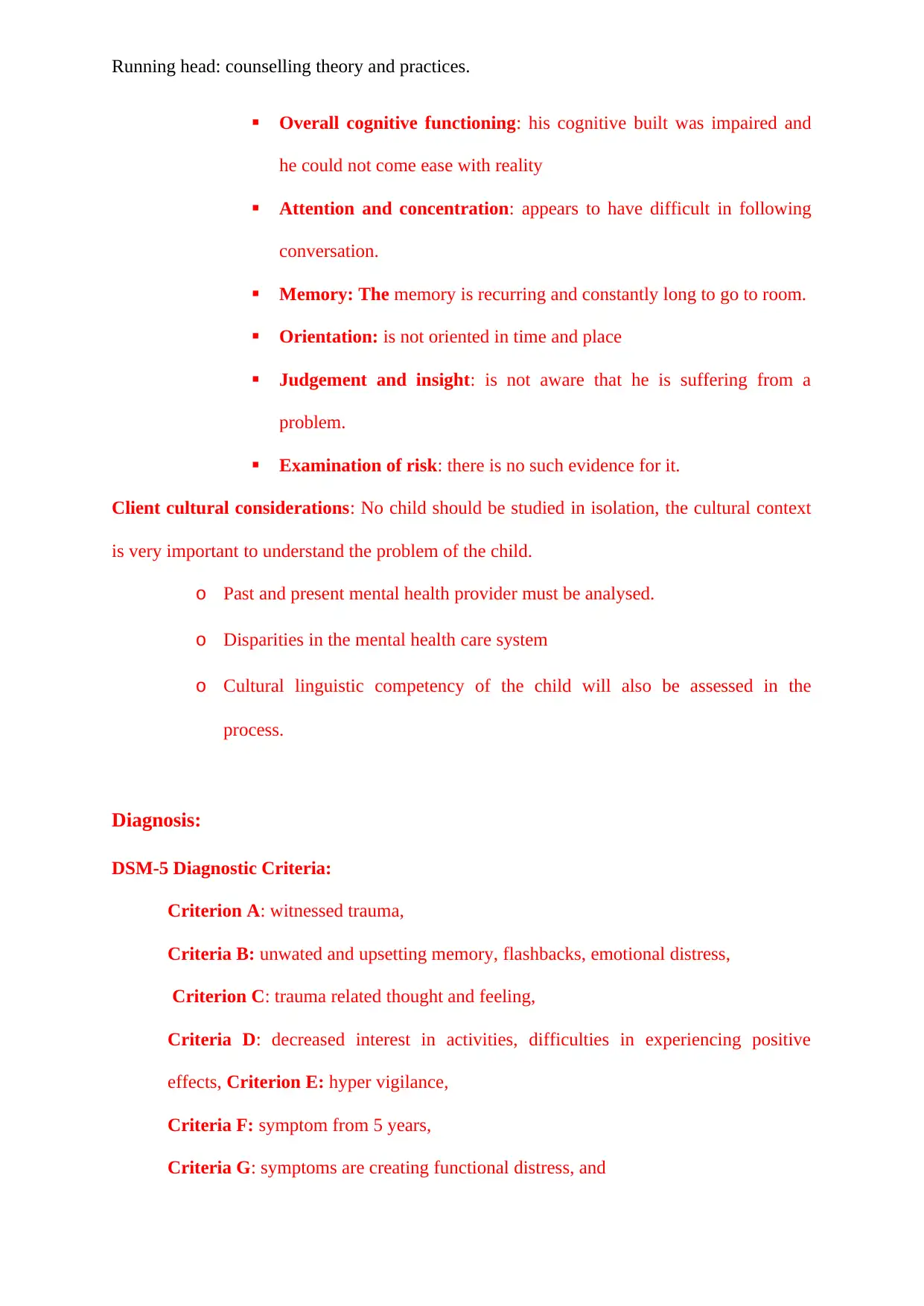
Running head: counselling theory and practices.
Overall cognitive functioning: his cognitive built was impaired and
he could not come ease with reality
Attention and concentration: appears to have difficult in following
conversation.
Memory: The memory is recurring and constantly long to go to room.
Orientation: is not oriented in time and place
Judgement and insight: is not aware that he is suffering from a
problem.
Examination of risk: there is no such evidence for it.
Client cultural considerations: No child should be studied in isolation, the cultural context
is very important to understand the problem of the child.
o Past and present mental health provider must be analysed.
o Disparities in the mental health care system
o Cultural linguistic competency of the child will also be assessed in the
process.
Diagnosis:
DSM-5 Diagnostic Criteria:
Criterion A: witnessed trauma,
Criteria B: unwated and upsetting memory, flashbacks, emotional distress,
Criterion C: trauma related thought and feeling,
Criteria D: decreased interest in activities, difficulties in experiencing positive
effects, Criterion E: hyper vigilance,
Criteria F: symptom from 5 years,
Criteria G: symptoms are creating functional distress, and
Overall cognitive functioning: his cognitive built was impaired and
he could not come ease with reality
Attention and concentration: appears to have difficult in following
conversation.
Memory: The memory is recurring and constantly long to go to room.
Orientation: is not oriented in time and place
Judgement and insight: is not aware that he is suffering from a
problem.
Examination of risk: there is no such evidence for it.
Client cultural considerations: No child should be studied in isolation, the cultural context
is very important to understand the problem of the child.
o Past and present mental health provider must be analysed.
o Disparities in the mental health care system
o Cultural linguistic competency of the child will also be assessed in the
process.
Diagnosis:
DSM-5 Diagnostic Criteria:
Criterion A: witnessed trauma,
Criteria B: unwated and upsetting memory, flashbacks, emotional distress,
Criterion C: trauma related thought and feeling,
Criteria D: decreased interest in activities, difficulties in experiencing positive
effects, Criterion E: hyper vigilance,
Criteria F: symptom from 5 years,
Criteria G: symptoms are creating functional distress, and
Secure Best Marks with AI Grader
Need help grading? Try our AI Grader for instant feedback on your assignments.
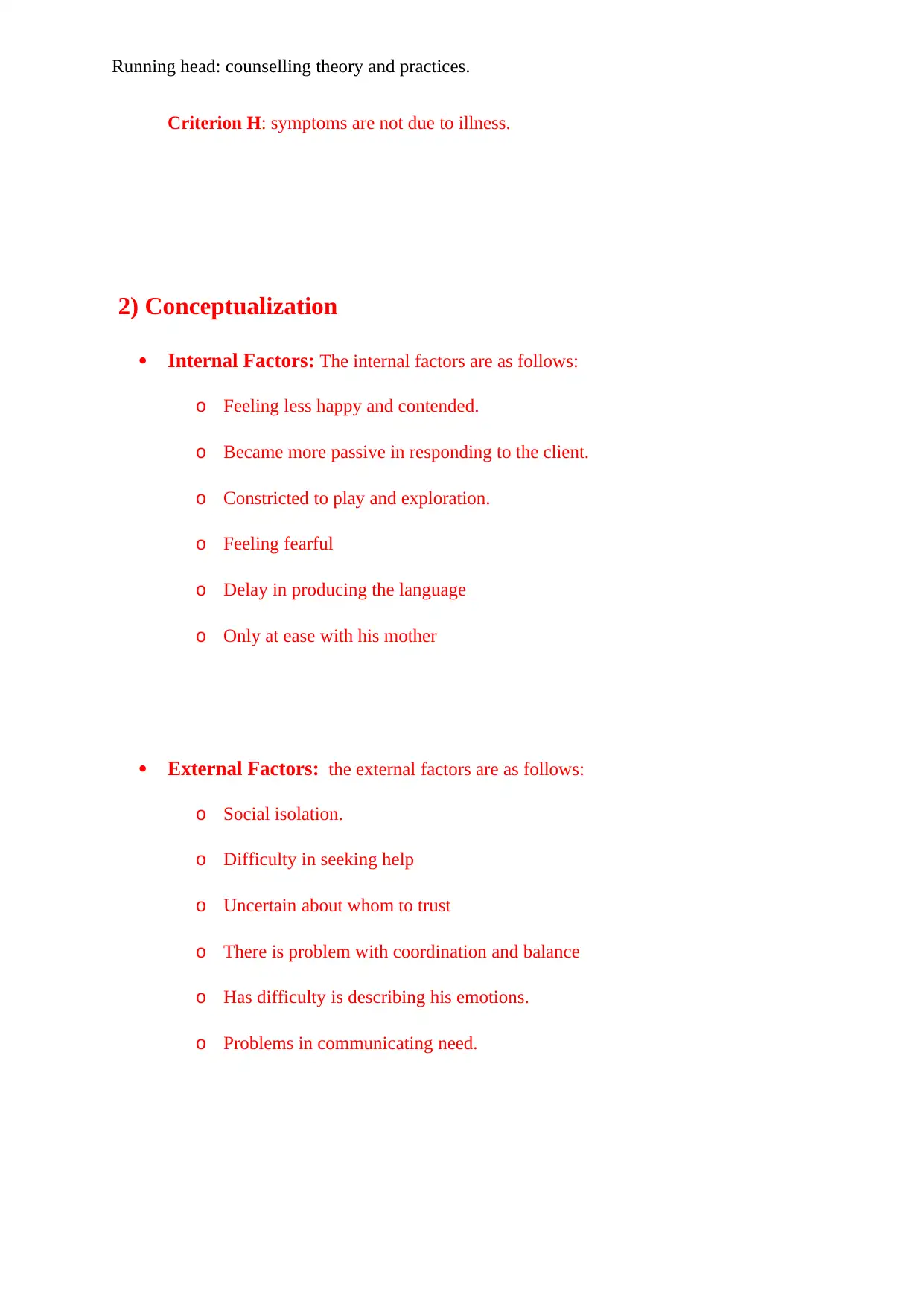
Running head: counselling theory and practices.
Criterion H: symptoms are not due to illness.
2) Conceptualization
Internal Factors: The internal factors are as follows:
o Feeling less happy and contended.
o Became more passive in responding to the client.
o Constricted to play and exploration.
o Feeling fearful
o Delay in producing the language
o Only at ease with his mother
External Factors: the external factors are as follows:
o Social isolation.
o Difficulty in seeking help
o Uncertain about whom to trust
o There is problem with coordination and balance
o Has difficulty is describing his emotions.
o Problems in communicating need.
Criterion H: symptoms are not due to illness.
2) Conceptualization
Internal Factors: The internal factors are as follows:
o Feeling less happy and contended.
o Became more passive in responding to the client.
o Constricted to play and exploration.
o Feeling fearful
o Delay in producing the language
o Only at ease with his mother
External Factors: the external factors are as follows:
o Social isolation.
o Difficulty in seeking help
o Uncertain about whom to trust
o There is problem with coordination and balance
o Has difficulty is describing his emotions.
o Problems in communicating need.
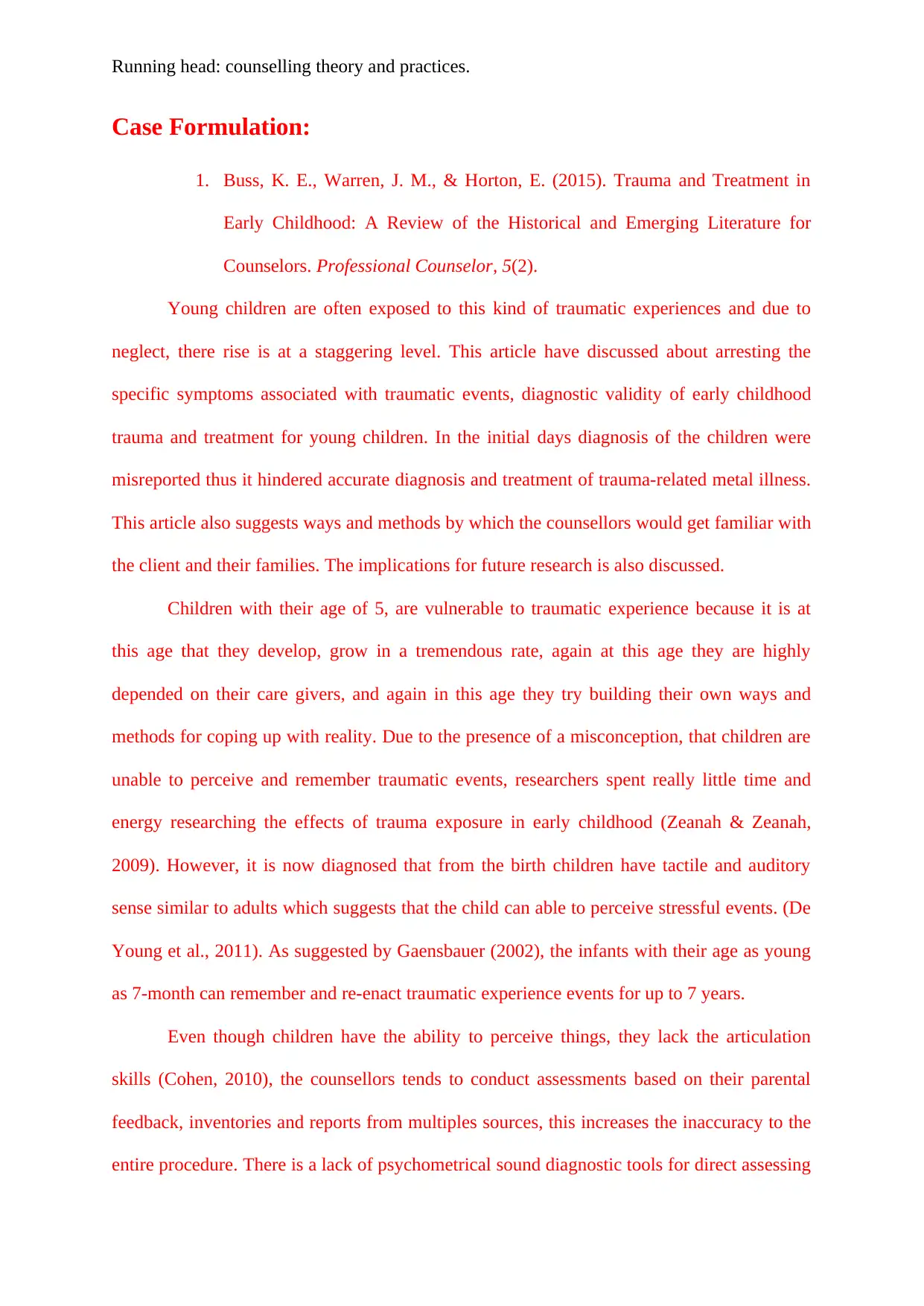
Running head: counselling theory and practices.
Case Formulation:
1. Buss, K. E., Warren, J. M., & Horton, E. (2015). Trauma and Treatment in
Early Childhood: A Review of the Historical and Emerging Literature for
Counselors. Professional Counselor, 5(2).
Young children are often exposed to this kind of traumatic experiences and due to
neglect, there rise is at a staggering level. This article have discussed about arresting the
specific symptoms associated with traumatic events, diagnostic validity of early childhood
trauma and treatment for young children. In the initial days diagnosis of the children were
misreported thus it hindered accurate diagnosis and treatment of trauma-related metal illness.
This article also suggests ways and methods by which the counsellors would get familiar with
the client and their families. The implications for future research is also discussed.
Children with their age of 5, are vulnerable to traumatic experience because it is at
this age that they develop, grow in a tremendous rate, again at this age they are highly
depended on their care givers, and again in this age they try building their own ways and
methods for coping up with reality. Due to the presence of a misconception, that children are
unable to perceive and remember traumatic events, researchers spent really little time and
energy researching the effects of trauma exposure in early childhood (Zeanah & Zeanah,
2009). However, it is now diagnosed that from the birth children have tactile and auditory
sense similar to adults which suggests that the child can able to perceive stressful events. (De
Young et al., 2011). As suggested by Gaensbauer (2002), the infants with their age as young
as 7-month can remember and re-enact traumatic experience events for up to 7 years.
Even though children have the ability to perceive things, they lack the articulation
skills (Cohen, 2010), the counsellors tends to conduct assessments based on their parental
feedback, inventories and reports from multiples sources, this increases the inaccuracy to the
entire procedure. There is a lack of psychometrical sound diagnostic tools for direct assessing
Case Formulation:
1. Buss, K. E., Warren, J. M., & Horton, E. (2015). Trauma and Treatment in
Early Childhood: A Review of the Historical and Emerging Literature for
Counselors. Professional Counselor, 5(2).
Young children are often exposed to this kind of traumatic experiences and due to
neglect, there rise is at a staggering level. This article have discussed about arresting the
specific symptoms associated with traumatic events, diagnostic validity of early childhood
trauma and treatment for young children. In the initial days diagnosis of the children were
misreported thus it hindered accurate diagnosis and treatment of trauma-related metal illness.
This article also suggests ways and methods by which the counsellors would get familiar with
the client and their families. The implications for future research is also discussed.
Children with their age of 5, are vulnerable to traumatic experience because it is at
this age that they develop, grow in a tremendous rate, again at this age they are highly
depended on their care givers, and again in this age they try building their own ways and
methods for coping up with reality. Due to the presence of a misconception, that children are
unable to perceive and remember traumatic events, researchers spent really little time and
energy researching the effects of trauma exposure in early childhood (Zeanah & Zeanah,
2009). However, it is now diagnosed that from the birth children have tactile and auditory
sense similar to adults which suggests that the child can able to perceive stressful events. (De
Young et al., 2011). As suggested by Gaensbauer (2002), the infants with their age as young
as 7-month can remember and re-enact traumatic experience events for up to 7 years.
Even though children have the ability to perceive things, they lack the articulation
skills (Cohen, 2010), the counsellors tends to conduct assessments based on their parental
feedback, inventories and reports from multiples sources, this increases the inaccuracy to the
entire procedure. There is a lack of psychometrical sound diagnostic tools for direct assessing

Running head: counselling theory and practices.
trauma symptoms in children (Strand, Pasquale, & Sarmiento, 2011). However, Yates
suggests that, there are well-designed instruments for early childhood that utilize indirect
assessments such as clinical observation and parents teacher reports.
Thus the importance of assessing jack is very crucial because of his tender age and it
is also important device proper and new methods of assessing his situation.
2. Eaton Allen, S. (2016). Childhood Trauma: A Comprehensive Review of
Effects, Assessments, and Treatments. Retrieved from
https://www.researchgate.net/publication/311125520_Childhood_Trauma_A_
Comprehensive_Review_of_Effects_Assessments_and_Treatments
The relevance of the point made in the previous article is stated in this article too.
Researchers found that, persistence exposure to stress or trauma can yield social problems,
high-risk behaviours and victimization and perpetration (Felitti, et al., 1998). This article
suggest the importance of the stress and its adverse impact on the child. It analysis the
conducted by Kaiser Permanete and the centre for disease control and prevention and shows
the persist impact of stress on the child facing trauma. The research also shows that children
exposed to toxic stress can show alternations throughout their entire genome (Weder, et al.,
2014). The stress factor also impacts the neural circuits, hormone and neurochemical systems
(Gunnar, 210: McEwen, 2008). These can effects the homeostasis during the childhood and
throughout the lifespan resulting in improper responses to neutral events (Loman & Gunnar:
McEwen, 2008). On the macro front, the implications of the ACE (Adverse Childhood
experiences) studies continue to infiltrate the communities all over the United States from
Trauma education for professional in and around Philadelphia to trauma-sensitive judicial
systems in Florida.
trauma symptoms in children (Strand, Pasquale, & Sarmiento, 2011). However, Yates
suggests that, there are well-designed instruments for early childhood that utilize indirect
assessments such as clinical observation and parents teacher reports.
Thus the importance of assessing jack is very crucial because of his tender age and it
is also important device proper and new methods of assessing his situation.
2. Eaton Allen, S. (2016). Childhood Trauma: A Comprehensive Review of
Effects, Assessments, and Treatments. Retrieved from
https://www.researchgate.net/publication/311125520_Childhood_Trauma_A_
Comprehensive_Review_of_Effects_Assessments_and_Treatments
The relevance of the point made in the previous article is stated in this article too.
Researchers found that, persistence exposure to stress or trauma can yield social problems,
high-risk behaviours and victimization and perpetration (Felitti, et al., 1998). This article
suggest the importance of the stress and its adverse impact on the child. It analysis the
conducted by Kaiser Permanete and the centre for disease control and prevention and shows
the persist impact of stress on the child facing trauma. The research also shows that children
exposed to toxic stress can show alternations throughout their entire genome (Weder, et al.,
2014). The stress factor also impacts the neural circuits, hormone and neurochemical systems
(Gunnar, 210: McEwen, 2008). These can effects the homeostasis during the childhood and
throughout the lifespan resulting in improper responses to neutral events (Loman & Gunnar:
McEwen, 2008). On the macro front, the implications of the ACE (Adverse Childhood
experiences) studies continue to infiltrate the communities all over the United States from
Trauma education for professional in and around Philadelphia to trauma-sensitive judicial
systems in Florida.
Paraphrase This Document
Need a fresh take? Get an instant paraphrase of this document with our AI Paraphraser
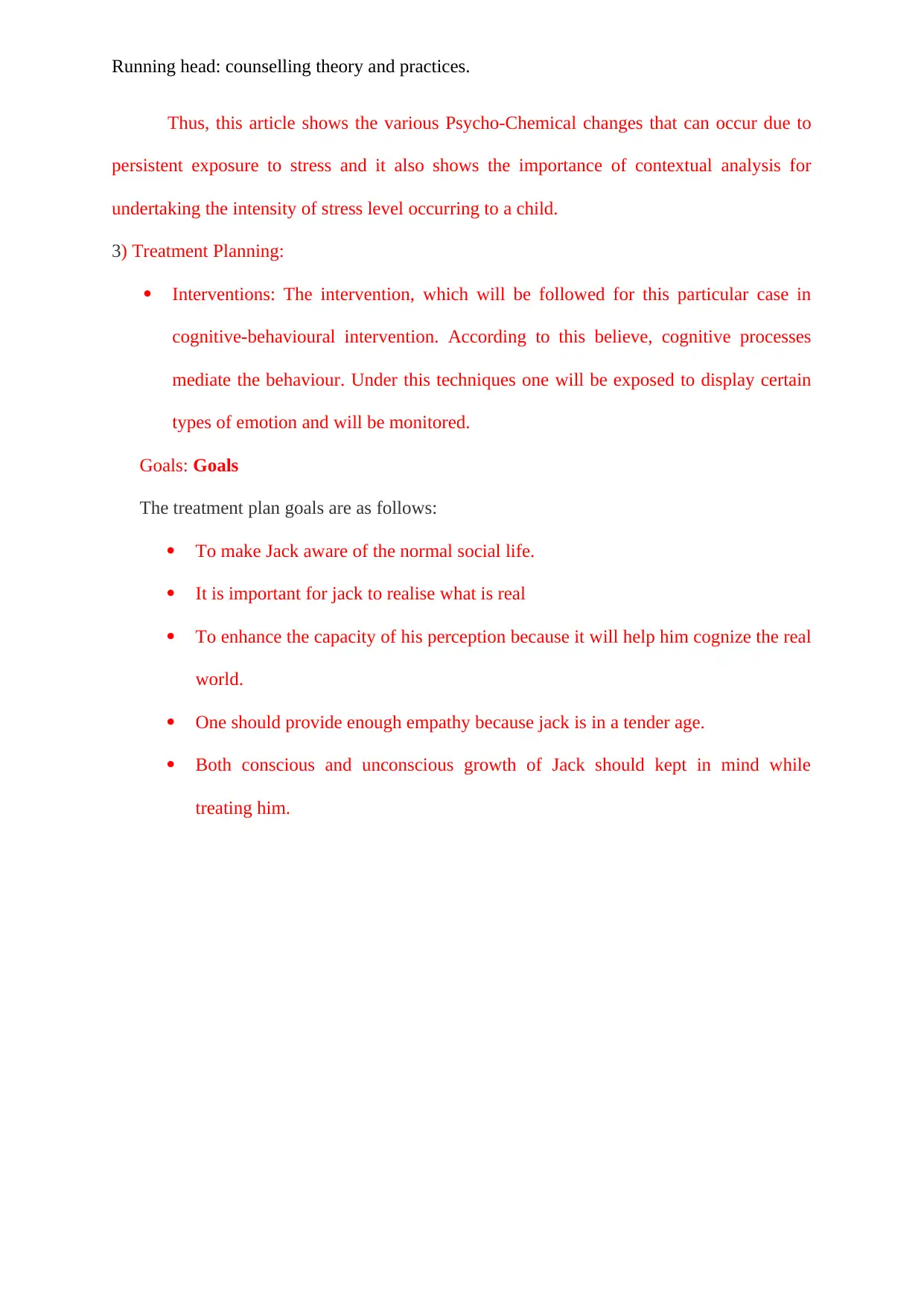
Running head: counselling theory and practices.
Thus, this article shows the various Psycho-Chemical changes that can occur due to
persistent exposure to stress and it also shows the importance of contextual analysis for
undertaking the intensity of stress level occurring to a child.
3) Treatment Planning:
Interventions: The intervention, which will be followed for this particular case in
cognitive-behavioural intervention. According to this believe, cognitive processes
mediate the behaviour. Under this techniques one will be exposed to display certain
types of emotion and will be monitored.
Goals: Goals
The treatment plan goals are as follows:
To make Jack aware of the normal social life.
It is important for jack to realise what is real
To enhance the capacity of his perception because it will help him cognize the real
world.
One should provide enough empathy because jack is in a tender age.
Both conscious and unconscious growth of Jack should kept in mind while
treating him.
Thus, this article shows the various Psycho-Chemical changes that can occur due to
persistent exposure to stress and it also shows the importance of contextual analysis for
undertaking the intensity of stress level occurring to a child.
3) Treatment Planning:
Interventions: The intervention, which will be followed for this particular case in
cognitive-behavioural intervention. According to this believe, cognitive processes
mediate the behaviour. Under this techniques one will be exposed to display certain
types of emotion and will be monitored.
Goals: Goals
The treatment plan goals are as follows:
To make Jack aware of the normal social life.
It is important for jack to realise what is real
To enhance the capacity of his perception because it will help him cognize the real
world.
One should provide enough empathy because jack is in a tender age.
Both conscious and unconscious growth of Jack should kept in mind while
treating him.

Running head: counselling theory and practices.
Interventional and Rationale
Interventional Rationale
In order to conduct, the sessions it is
important to maintain a calm, non-
threatening atmosphere.
Anxiety is contagious and it might
transfer from the heath care provider to
the client. Thus, the client may develop
feelings of insecurity in the presence of
the counsellor.
It is very important to build a
relationship that is informed truth and
faith, this attitude will develop when the
counsellor will display warmth and offer
unconditional acceptance.
The therapeutic skills need to be directed
towards the client], where client feel at
ease.
It is also expected of the counsellor to
remain with the client when he or she is
not feeling well.
The clients’ safety and security is the
utmost priority and it is very important
that the client should not be left alone or
else his anxiety will escalate.
Along with providing comfortableness,
it is also important for the counsellor to
educate the client.
In this the client will informed about the
treatments that are taking place for his
case. In this way, he or she will also be
able to understand the importance of the
treatment that is taking place for curing
him.
Interventional and Rationale
Interventional Rationale
In order to conduct, the sessions it is
important to maintain a calm, non-
threatening atmosphere.
Anxiety is contagious and it might
transfer from the heath care provider to
the client. Thus, the client may develop
feelings of insecurity in the presence of
the counsellor.
It is very important to build a
relationship that is informed truth and
faith, this attitude will develop when the
counsellor will display warmth and offer
unconditional acceptance.
The therapeutic skills need to be directed
towards the client], where client feel at
ease.
It is also expected of the counsellor to
remain with the client when he or she is
not feeling well.
The clients’ safety and security is the
utmost priority and it is very important
that the client should not be left alone or
else his anxiety will escalate.
Along with providing comfortableness,
it is also important for the counsellor to
educate the client.
In this the client will informed about the
treatments that are taking place for his
case. In this way, he or she will also be
able to understand the importance of the
treatment that is taking place for curing
him.

Running head: counselling theory and practices.
Case Summary and Evaluation
The character of Jack has been trained in certain way that made him believe the real
only exist next to his immediate space and nothing was real apart form that. Therefore,
cognition therapy will be most appropriate in this case because he has been ignorant of many
other aspects of reality (Corey, 2012). Since he is only a child and all he considers real is his
mother it is very important to build an approach in a non-authoritative fashion. Along with
the cognitive and existential therapy, the child also needs a person- centred therapy.
According to this therapy, the therapists acts as a compassionate facilitator who will listen
without making any judgement and will acknowledge the client’s experience. The cognitive
therapy refers to the psychosocial interventions that will help him to improve his health. Just
because he was not aware of the things present outside the room, he has started believing and
that is how he is generating his feelings. The thoughts are resulting due to the feelings has
inculcated and that is externally presented in the form of behaviour. The cognitive therapy
model is based on the behavioural and cognitive psychology that will help him to regulate his
emotion and help him to re-structure his unconscious mind and help him to formulate
meanings behind them. The existential therapy approach will also be effective because it lays
emphasises on the human condition as a whole. According to this approach, Jack will grow a
positive attitude towards his life and simultaneously address the human limitation. He will be
able to applaud the human capacities and come into even terms with the reality of his life. In
this way, he will also be able to distinguish effectively the real and the unreal aspect of the
life.
3) Treatment Plan
Issue
The condition of Jack is in a vulnerable state because he is not able to comprehend the
reality, that is, he is not able to attach meaning to the new and alien world. Thus, it can be
Case Summary and Evaluation
The character of Jack has been trained in certain way that made him believe the real
only exist next to his immediate space and nothing was real apart form that. Therefore,
cognition therapy will be most appropriate in this case because he has been ignorant of many
other aspects of reality (Corey, 2012). Since he is only a child and all he considers real is his
mother it is very important to build an approach in a non-authoritative fashion. Along with
the cognitive and existential therapy, the child also needs a person- centred therapy.
According to this therapy, the therapists acts as a compassionate facilitator who will listen
without making any judgement and will acknowledge the client’s experience. The cognitive
therapy refers to the psychosocial interventions that will help him to improve his health. Just
because he was not aware of the things present outside the room, he has started believing and
that is how he is generating his feelings. The thoughts are resulting due to the feelings has
inculcated and that is externally presented in the form of behaviour. The cognitive therapy
model is based on the behavioural and cognitive psychology that will help him to regulate his
emotion and help him to re-structure his unconscious mind and help him to formulate
meanings behind them. The existential therapy approach will also be effective because it lays
emphasises on the human condition as a whole. According to this approach, Jack will grow a
positive attitude towards his life and simultaneously address the human limitation. He will be
able to applaud the human capacities and come into even terms with the reality of his life. In
this way, he will also be able to distinguish effectively the real and the unreal aspect of the
life.
3) Treatment Plan
Issue
The condition of Jack is in a vulnerable state because he is not able to comprehend the
reality, that is, he is not able to attach meaning to the new and alien world. Thus, it can be
Secure Best Marks with AI Grader
Need help grading? Try our AI Grader for instant feedback on your assignments.

Running head: counselling theory and practices.
concluded that he is in the state of trauma, which is not pronounced one but it can be
detrimental if not treated properly.
Theoretical approach
The approach that I have taken is a person-centred and it is based on the non-authoritative
approach, which will allow my clients to take a lead in the discussion and discover theory
own problems. This will also boost the self-confidence and provide Jack with stronger sense
of identity. Therefore, he will be able to make sense of reality and interpersonal relationship
in a systematic manner.
Part two
Using the course text, the student will develop their personal counselling theory based on
their:
My personal counselling will involve strategic amalgamation of three therapies,
which are existential, cognitive, and personal care therapy. The values are more based on the
interpretative understanding rather than imposing set of standards to the client. It is also due
to the tender age the client is in. The belief system, which is working underneath, is the result
of an attempt to empathetic understanding, where the dignity of individual is given prime
importance. Thus, the relationship is given important and the pathology is treated rather than
just the diagnosis of the symptoms. The theory that is implied in this development of my
personal care therapy in formed by the interpretative paradigms, which was funded in the
Verstehen approach of Max Weber. The techniques that will be use are, discussion, MSE
exam, DSM-5 Diagnostic Criteria, and other cultural consideration will also be followed
along with the monitoring cognitive emotions.
Choose one theory from the course (different from the above) and analyse it from a
multicultural perspective.
concluded that he is in the state of trauma, which is not pronounced one but it can be
detrimental if not treated properly.
Theoretical approach
The approach that I have taken is a person-centred and it is based on the non-authoritative
approach, which will allow my clients to take a lead in the discussion and discover theory
own problems. This will also boost the self-confidence and provide Jack with stronger sense
of identity. Therefore, he will be able to make sense of reality and interpersonal relationship
in a systematic manner.
Part two
Using the course text, the student will develop their personal counselling theory based on
their:
My personal counselling will involve strategic amalgamation of three therapies,
which are existential, cognitive, and personal care therapy. The values are more based on the
interpretative understanding rather than imposing set of standards to the client. It is also due
to the tender age the client is in. The belief system, which is working underneath, is the result
of an attempt to empathetic understanding, where the dignity of individual is given prime
importance. Thus, the relationship is given important and the pathology is treated rather than
just the diagnosis of the symptoms. The theory that is implied in this development of my
personal care therapy in formed by the interpretative paradigms, which was funded in the
Verstehen approach of Max Weber. The techniques that will be use are, discussion, MSE
exam, DSM-5 Diagnostic Criteria, and other cultural consideration will also be followed
along with the monitoring cognitive emotions.
Choose one theory from the course (different from the above) and analyse it from a
multicultural perspective.

Running head: counselling theory and practices.
Integrative counselling as the name suggests is the amalgamation of different theories,
the therapist do not take single approach. Each person is considered as whole and the
counselling practices is tailored according to it. Integrative therapy approach advocates on the
need to infuse person’s personality and need within one therapy. According to the
multicultural perspective, various variables like race, ethnicity or religion offers a pluralistic
notion to the identity of the individual. Integrative model is mostly accused of using one-
dimensional models of cross-cultural counselling and psychotherapy. Integrative therapy is
premised on the various ways in which one can explore the functioning. However, the
integration of various practices may sound good but one need to understand the possible
consequences of such practices in the context of larger whole. In the age of globalization
when there is a rise of multicultural practices, when there is a slow disintegration of rigid
cultural practices, people are becoming more mobile and are aspiring to reach and discover
newer avenues, integration of different psychological therapy can be dangerous. Based on
this understanding it important to understand that the difference between integration and
eclecticism. Too much integration of therapy can fails the ultimate cause of the therapy,
resulting in muddled up process. However, sometimes integration can result due to the
inconsistencies between theories, techniques or for its underlying attitudes and values.
Without gaining much information about the client one my impose the integration therapy
which can turn as a pragmatic approach. This is because the focus has been given too much
of the pragmatic feature of the client and thus can result in superficiality. Again integration of
all therapist may be very relative because every person is characterised with different
attitudes, behaviours and belief- systems. However, sometime due to lack of experiences the
therapist may muddles up all the therapies, which might not suit the client. Thus, the
integrative flexibility can use the flexibility of integrative model in a defensive manner.
Sometime, the transferential and relational implications of switching between the modalities
Integrative counselling as the name suggests is the amalgamation of different theories,
the therapist do not take single approach. Each person is considered as whole and the
counselling practices is tailored according to it. Integrative therapy approach advocates on the
need to infuse person’s personality and need within one therapy. According to the
multicultural perspective, various variables like race, ethnicity or religion offers a pluralistic
notion to the identity of the individual. Integrative model is mostly accused of using one-
dimensional models of cross-cultural counselling and psychotherapy. Integrative therapy is
premised on the various ways in which one can explore the functioning. However, the
integration of various practices may sound good but one need to understand the possible
consequences of such practices in the context of larger whole. In the age of globalization
when there is a rise of multicultural practices, when there is a slow disintegration of rigid
cultural practices, people are becoming more mobile and are aspiring to reach and discover
newer avenues, integration of different psychological therapy can be dangerous. Based on
this understanding it important to understand that the difference between integration and
eclecticism. Too much integration of therapy can fails the ultimate cause of the therapy,
resulting in muddled up process. However, sometimes integration can result due to the
inconsistencies between theories, techniques or for its underlying attitudes and values.
Without gaining much information about the client one my impose the integration therapy
which can turn as a pragmatic approach. This is because the focus has been given too much
of the pragmatic feature of the client and thus can result in superficiality. Again integration of
all therapist may be very relative because every person is characterised with different
attitudes, behaviours and belief- systems. However, sometime due to lack of experiences the
therapist may muddles up all the therapies, which might not suit the client. Thus, the
integrative flexibility can use the flexibility of integrative model in a defensive manner.
Sometime, the transferential and relational implications of switching between the modalities

Running head: counselling theory and practices.
may not be sufficient attended to, for this there is need to address to particular therapy model.
This model is synthesis of humanistic psychotherapy, object relations theory, and
psychoanalytic self-psychology. However, the only danger is possess is it lack of definite
attributes it focuses on the evolving relationship between the client and therapist. However, in
the multi-cultural perspectives, one needs to address the development is definite model in
order to understand the person placed in the context. The social and cultural factors should
also be more importance.
Student will then compare and contrast it to their personal counselling theory
In my personal counselling theory, I have used, existential therapy, along with
cognitive and personal care therapy. There is sufficient reason or me choosing the therapies
because I have addressed the section of my client minutely. Jack is only five years of his age,
thus he is still in that age group where he is dependent on his primary circle. Therefore, he is
in need of a person centred therapy, where all his concerns will be death in a compassionate
manner. This is different from the integrationist therapy because according to the person-
centred therapy the person is viewed from its context. This includes environment, autonomy,
the values, and the belief system of the person. Since the beginning of his age he could not
learn to perceive properly, thus has poor cognitive ability. This approach will make him
understand what to value as real and this is how he can learn to distinguish between the fake
and real world. The cognition for the development process will be aided with the existential
philosophy, where he will realise and discover the pre-set pattern social reality. This will hell
him to cognize the social skills and hence will be able to develop a proper social life.
I have design my therapy exclusively for him keeping in mind the disorder that Jack is
suffering from. Since he is unable to understand that things have already taken a turn and he
will never get back the way ways he is used to. He will be agonized by the existing
relationship thus t is very important to make him realise about the importance of the present.
may not be sufficient attended to, for this there is need to address to particular therapy model.
This model is synthesis of humanistic psychotherapy, object relations theory, and
psychoanalytic self-psychology. However, the only danger is possess is it lack of definite
attributes it focuses on the evolving relationship between the client and therapist. However, in
the multi-cultural perspectives, one needs to address the development is definite model in
order to understand the person placed in the context. The social and cultural factors should
also be more importance.
Student will then compare and contrast it to their personal counselling theory
In my personal counselling theory, I have used, existential therapy, along with
cognitive and personal care therapy. There is sufficient reason or me choosing the therapies
because I have addressed the section of my client minutely. Jack is only five years of his age,
thus he is still in that age group where he is dependent on his primary circle. Therefore, he is
in need of a person centred therapy, where all his concerns will be death in a compassionate
manner. This is different from the integrationist therapy because according to the person-
centred therapy the person is viewed from its context. This includes environment, autonomy,
the values, and the belief system of the person. Since the beginning of his age he could not
learn to perceive properly, thus has poor cognitive ability. This approach will make him
understand what to value as real and this is how he can learn to distinguish between the fake
and real world. The cognition for the development process will be aided with the existential
philosophy, where he will realise and discover the pre-set pattern social reality. This will hell
him to cognize the social skills and hence will be able to develop a proper social life.
I have design my therapy exclusively for him keeping in mind the disorder that Jack is
suffering from. Since he is unable to understand that things have already taken a turn and he
will never get back the way ways he is used to. He will be agonized by the existing
relationship thus t is very important to make him realise about the importance of the present.
Paraphrase This Document
Need a fresh take? Get an instant paraphrase of this document with our AI Paraphraser

Running head: counselling theory and practices.
Current thinking is very important for him thus assertive exercises, role-playing and
homework can serve as a beneficial therapy to Jack. Again, he will be aided with a humanist
approaches were the working of his conscious mid would be addressed affectively. Thus I am
therapy will comprises all the elements which will help him to bridge the gap from his
conscious world to unconscious world.
Current thinking is very important for him thus assertive exercises, role-playing and
homework can serve as a beneficial therapy to Jack. Again, he will be aided with a humanist
approaches were the working of his conscious mid would be addressed affectively. Thus I am
therapy will comprises all the elements which will help him to bridge the gap from his
conscious world to unconscious world.
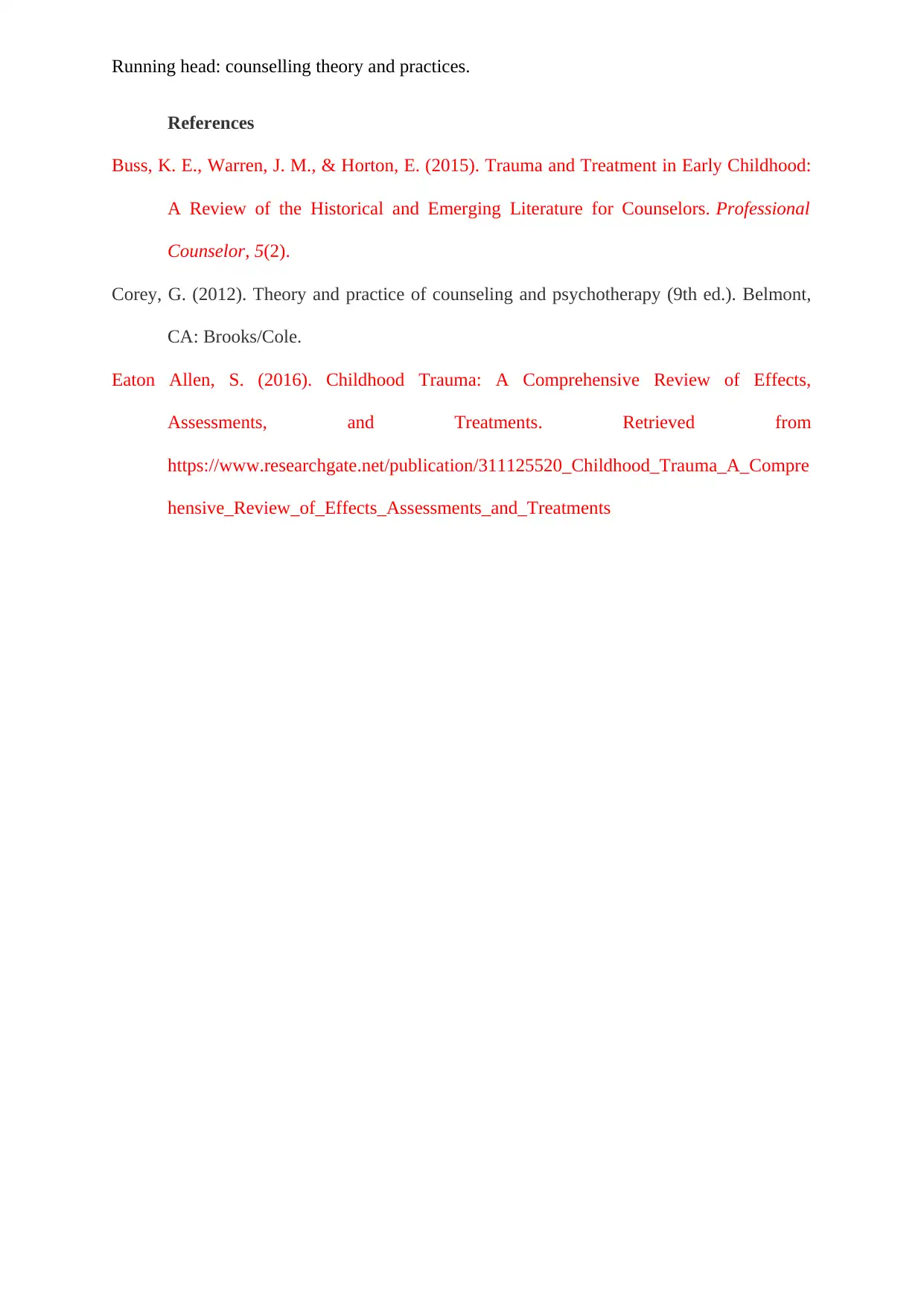
Running head: counselling theory and practices.
References
Buss, K. E., Warren, J. M., & Horton, E. (2015). Trauma and Treatment in Early Childhood:
A Review of the Historical and Emerging Literature for Counselors. Professional
Counselor, 5(2).
Corey, G. (2012). Theory and practice of counseling and psychotherapy (9th ed.). Belmont,
CA: Brooks/Cole.
Eaton Allen, S. (2016). Childhood Trauma: A Comprehensive Review of Effects,
Assessments, and Treatments. Retrieved from
https://www.researchgate.net/publication/311125520_Childhood_Trauma_A_Compre
hensive_Review_of_Effects_Assessments_and_Treatments
References
Buss, K. E., Warren, J. M., & Horton, E. (2015). Trauma and Treatment in Early Childhood:
A Review of the Historical and Emerging Literature for Counselors. Professional
Counselor, 5(2).
Corey, G. (2012). Theory and practice of counseling and psychotherapy (9th ed.). Belmont,
CA: Brooks/Cole.
Eaton Allen, S. (2016). Childhood Trauma: A Comprehensive Review of Effects,
Assessments, and Treatments. Retrieved from
https://www.researchgate.net/publication/311125520_Childhood_Trauma_A_Compre
hensive_Review_of_Effects_Assessments_and_Treatments
1 out of 15
Your All-in-One AI-Powered Toolkit for Academic Success.
+13062052269
info@desklib.com
Available 24*7 on WhatsApp / Email
![[object Object]](/_next/static/media/star-bottom.7253800d.svg)
Unlock your academic potential
© 2024 | Zucol Services PVT LTD | All rights reserved.